For schools today, the challenge of marketing doesn’t end with capturing the interest of prospective students; you need to be able to engage and nurture that interest over time. The solution? A newsletter marketing strategy.
Newsletter marketing involves sending informational content via email to subscribers on a mailing list. When a prospect signs up for your newsletter, they demonstrate some interest in your school. They want to learn more. By delivering consistent, personalized content, your newsletter is a means of sustaining and satisfying that interest. You can use newsletters to invite prospects to upcoming events, advertise specific program offerings and introduce them to the unique selling points of your school.
In the digital age, it’s easier than ever to reach potential applicants, yet it can be difficult to develop a meaningful relationship with them. A newsletter is a way of initiating prospects into your school’s community and solidifying their connection to your brand. Read on for a closer look at the key benefits of a newsletter marketing strategy for driving interest in your school.

1. Target an Already Engaged Audience
One of the biggest advantages of a digital newsletter marketing strategy is that it targets those who have indicated an interest in your institution. To receive a school’s newsletter, prospects must first give you permission by opting in and subscribing to the mailing list. Instead of shooting in the dark, you can rest assured that you’re directing your marketing efforts toward an audience that’s interested.
While you can generate a mailing list for your newsletter in a number of ways, it’s best to give users the opportunity to sign up via your website. That way, you can be sure that you are investing time and resources in delivering content to recipients who want it.
Example: This welcome email from the University of Pennsylvania openly informs prospects that they have just joined their Undergraduate Admissions mailing list. It gives them a brief idea of what they can expect from future newsletters, along with the chance to review and update their contact information.

Source: University of Pennsylvania
Not only is a newsletter a great way to focus your marketing efforts, but it also helps to enhance the credibility of your institution. No one wants to receive unsolicited emails, and by implementing a transparent email campaign, you can uphold the reputation of your brand and avoid deterring leads with unwanted content.
Build a Consistent Image of Your Brand
Once your school has generated marketing qualified leads (MQLs), newsletters become valuable tools for nurturing them along with opportunities for micro-conversions while strengthening brand recognition among those leads. In today’s education market, schools are met with the challenge of standing out from the crowd. Like any other content that your school creates, your newsletter should differentiate your brand and leave a lasting impression on prospects. By giving you a direct line of communication with your subscribers, a newsletter is a chance for you to emphasize your school’s values and unique selling points through consistent messaging.
For example, the University of Alberta uses its newsletter to hammer home some key messages to international prospects. Information on the school’s ranking, financial aid program and post-graduation employment rates all work to build a unique image of the institution and its offerings.

Source: University of Alberta
The visual design of a newsletter is also particularly valuable to your school. Whatever type of content you’re creating, visuals increase a viewer’s desire to engage by 80%. Logos, images and colour schemes used consistently across newsletters can all help to cement your school’s image in the minds of prospective students. For example, a welcome newsletter from McMaster University features a GIF header, designed using its school colours along with its signature slogan “A Brighter World.”
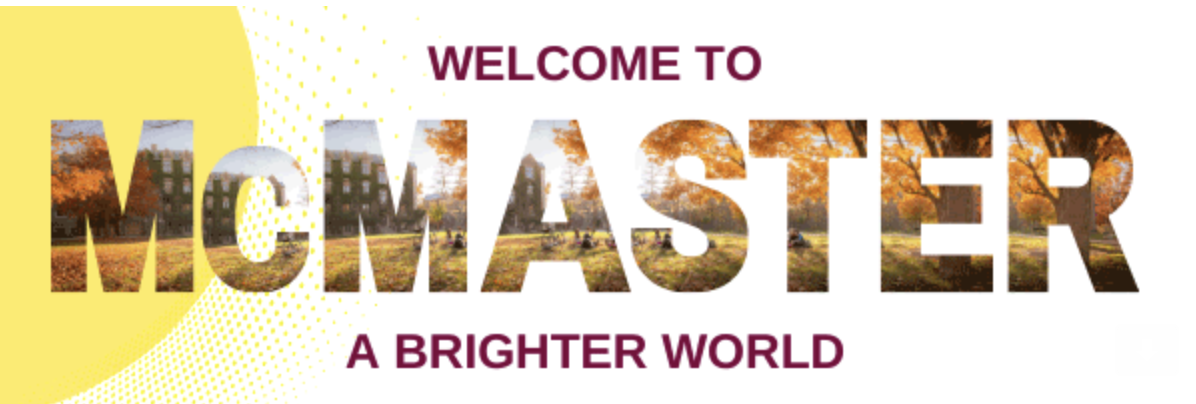
The school’s logo, colours and slogan are also repeated in a banner at the end of the newsletter to help the email stand out in a recipient’s inbox.
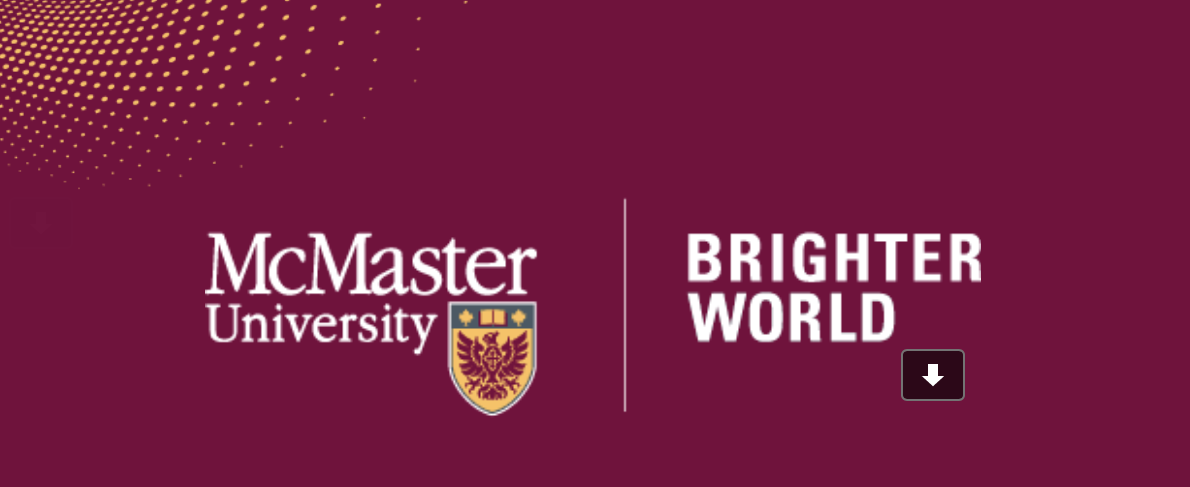
Source: McMaster University
With a school newsletter, not only are prospects receiving valuable information about your institution, but they are also receiving visual reminders that reinforce their awareness of your brand.
2. Deliver Targeted Messages that Appeal to Prospects’ Interests
Prospective students are most likely to engage with content that speaks to their own needs and desires. The best part about a newsletter is that you can tailor its content according to the interests of subscribers. With personalized newsletters, you can engage prospects at any stage of their journey.
Promote Specific Educational Programs
When searching for the right school for their education, many prospects will be drawn to an institution because of its program offerings or reputation in a certain field. In that case, they’ll want to know more about what your school offers in that specific area. For many schools, the best way to deliver targeted messages is by giving potential applicants the chance to register their educational interests when they sign up for the mailing list.
On Duke University’s website, the registration form for its mailing list lets users specify what type of applicant they are (First Year or Transfer) when they plan to attend college and their area of academic interest. This way, the school can work to target the right leads with the right content to boost student enrolment.
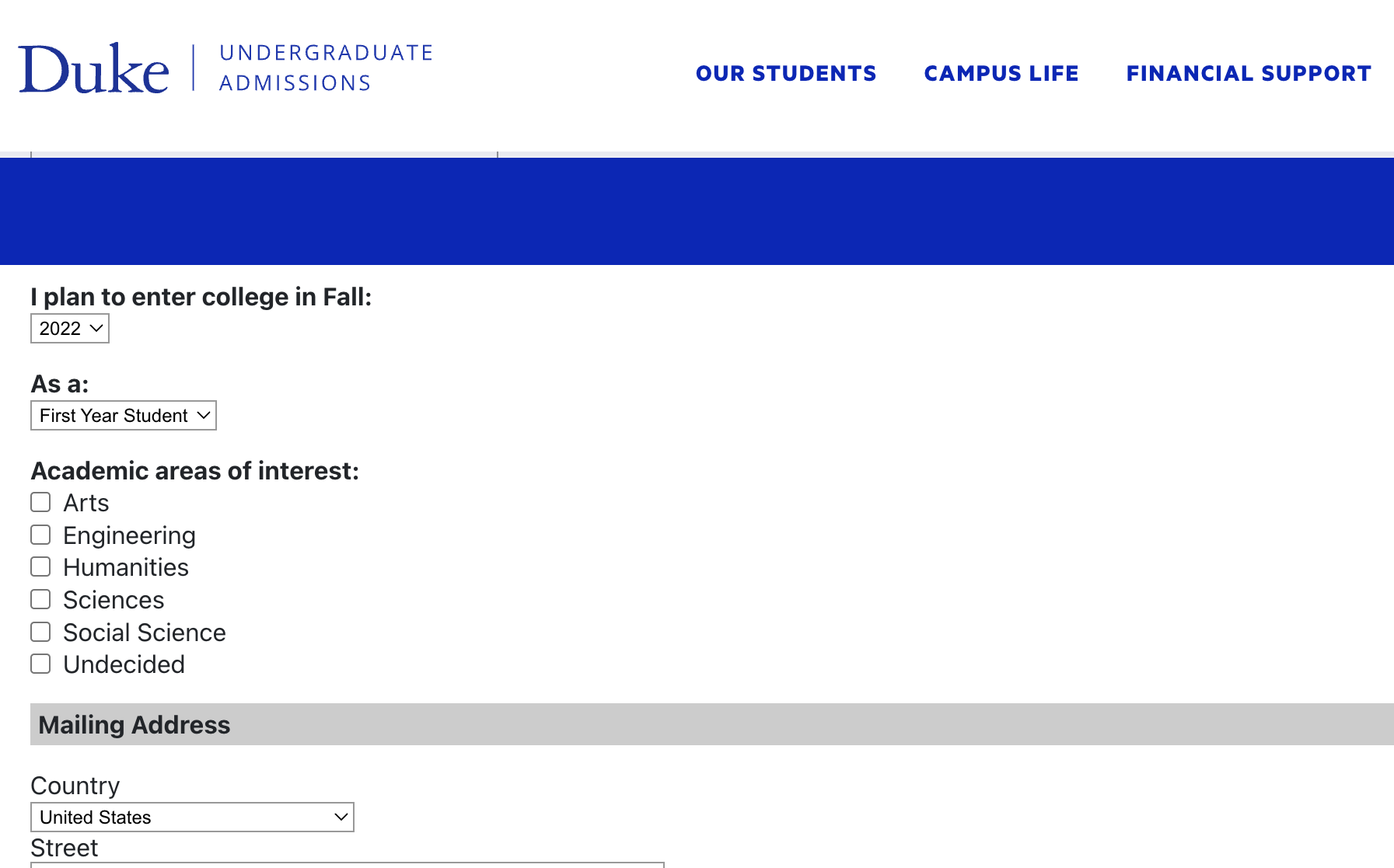
Source: Duke University
Once you know which faculty, program and level of study a prospect is interested in, your newsletter allows you to deliver precise and informed content that satisfies their curiosity.
In the example below, prospective students who register their interest in McMaster’s Engineering program receive a newsletter from the relevant faculty.
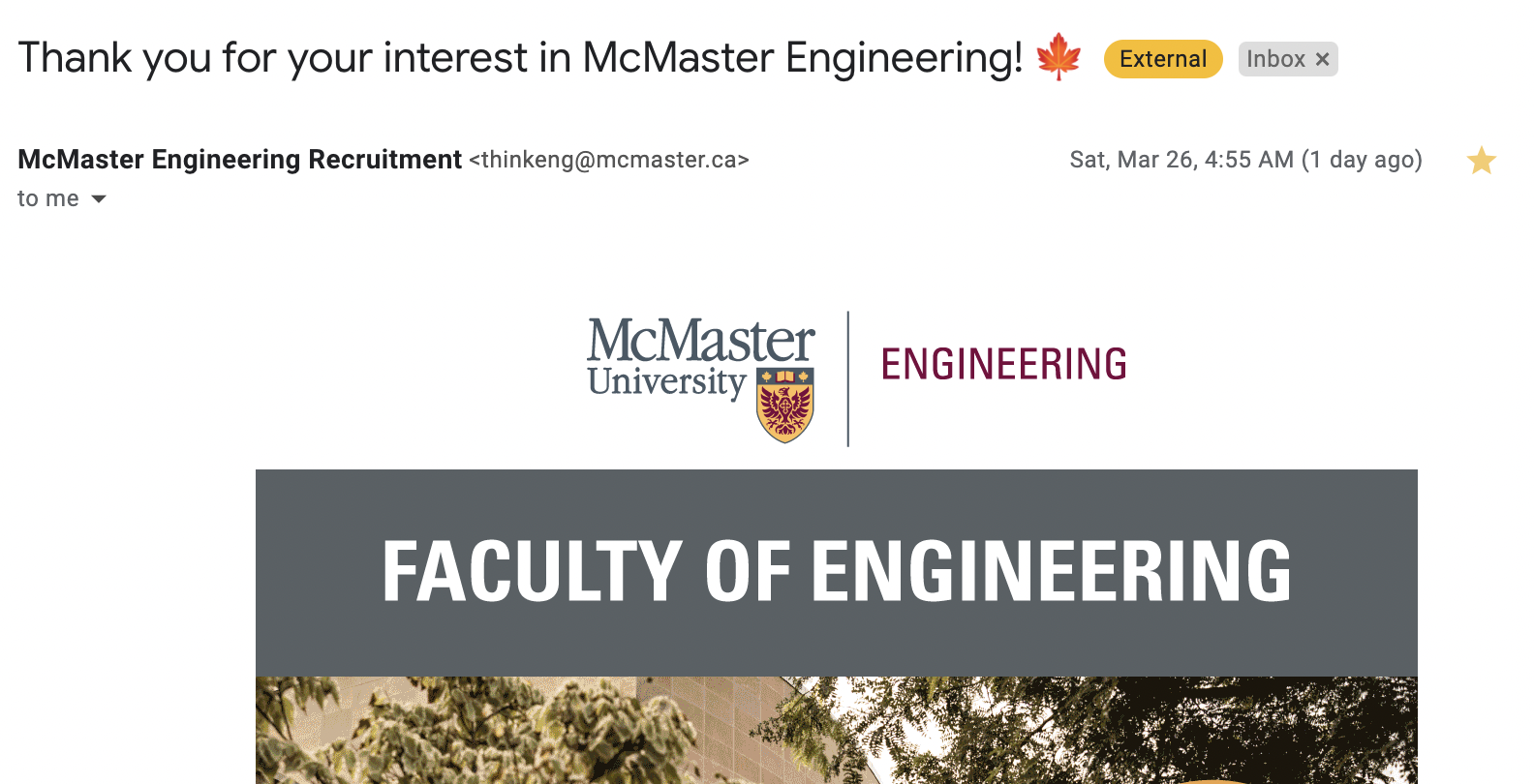
Source: McMaster University
Along with more general messaging about the school, this kind of newsletter is a chance to promote specific programs and introduce prospects to a community that is aligned with their own interests and goals.
3. Nurture Leads Easily With Automated Workflows
In the digital age, 9 out of every 10 marketers use email to distribute their content. This is partly thanks to automated email marketing campaigns that make this line of communication so easy. Marketing automation platforms like HubSpot, Mautic by HEM or Marketo allow you to implement an efficient strategy for sending dynamic content to the right people at the right time. A school newsletter is a great opportunity to put this software into action.
With an automated newsletter, your school can reach a wider audience base at every little cost. You can use automated workflows to segment your subscribers and schedule personalized newsletters that will engage them at every point in the enrolment journey. Once subscribers have identified their own interests, they will receive a newsletter that meets their individualized needs. For both large and small institutions, this automation process is a low-effort solution to utilize digital strategies to save time and money through communication.
Prospects Can Access Your Content Anytime, Anywhere
The convenience of an automated email campaign doesn’t end with your school; recipients can also enjoy the benefit of being able to access important information right in their inbox. Email remains one of the most prominent parts of daily online life. In 2020, there were four billion global e-mail users, with that number expected to reach 4.6 billion in 2025. By incorporating a newsletter into your marketing strategy, you can be sure to reach prospects where their attention lies.
If you want to make the most of this opportunity, consider optimizing your newsletter with a mobile-friendly design. As our digital platforms evolve, so do the devices we use to access them. With more than 50% of email campaigns viewed on a mobile device, an optimized newsletter is a great way to meet your audience wherever they are.
Example: A newsletter from the University of Washington features a clean and organized design that allows users to view the content, banner and subject line easily from their mobile application. Various links in the email, including a video link, also direct users to the school’s mobile-optimized website for more information.
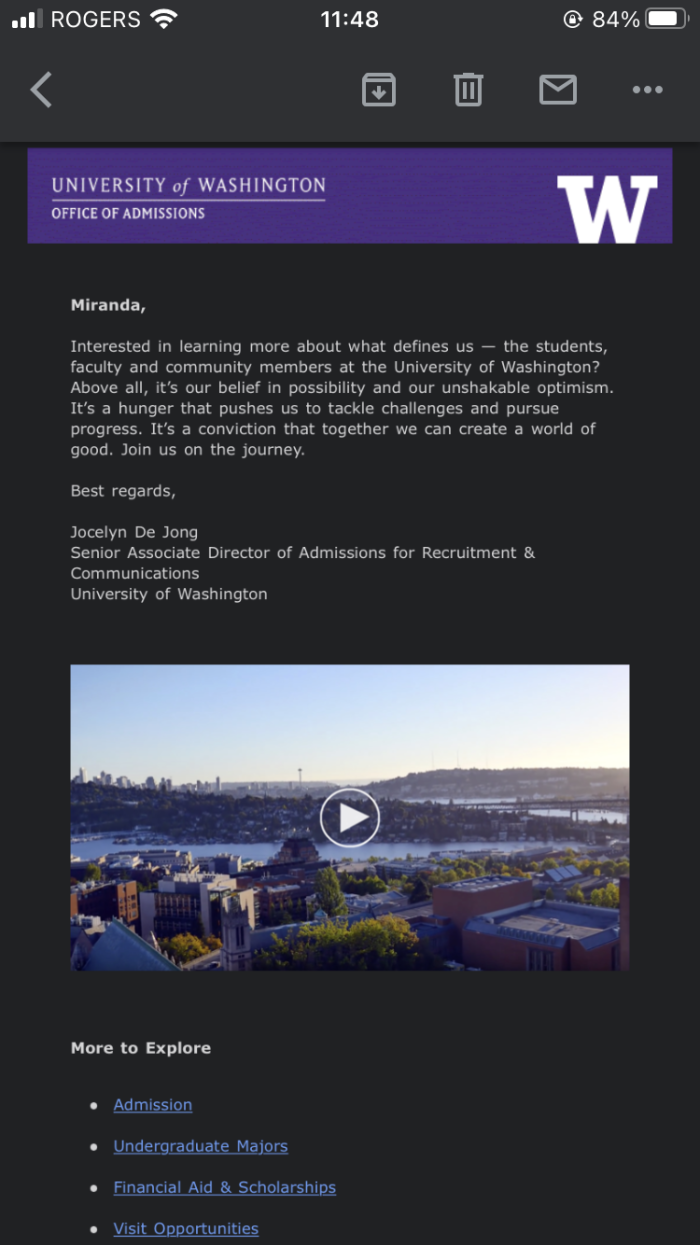
Source: University of Washington
By meeting prospects with accessible and readable content, you make their ability to engage with your school that much easier.
Lead Prospects to Take Action
Of course, all of your inbound marketing strategies should lead somewhere. When you master the design and content, an automated newsletter campaign is a perfect vehicle to lead prospects through the enrolment funnel. Each newsletter you send is a chance to nurture new leads at every stage of their journey, informing their interest in your school and guiding them through the application process.
Targeted CTAs are some of the most compelling elements of a newsletter. These give recipients multiple opportunities to engage with your school and its offerings at every corner. A CTA could do anything from leading prospects to register for an event, download a program brochure, schedule an appointment or fill out an application.
The example below shows a section of a newsletter from the University of San Diego. The standout CTA “Watch Now!” leads recipients to a short video where they learn more about the city and envision their own life there.

Source: University of San Diego
Similarly, the content of a newsletter from McGill University is sandwiched between two CTAs: “Find my program” and “Explore my options.” Each one directs readers to the university’s webpage, where they can browse the programs on offer.
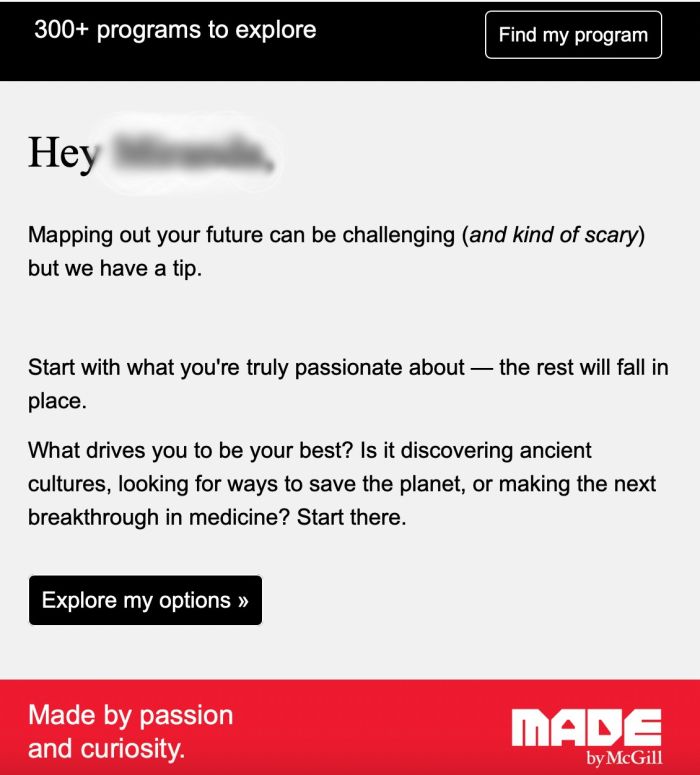
Source: McGill University
Whichever path you’re hoping to promote, with clear and strategic CTAs embedded in the content, your school’s newsletters allow prospective students to turn their interest into action.
4. Increase Attendance at Upcoming Events With a Newsletter Marketing Strategy
Events such as open days and information sessions are crucial in shaping a prospect’s decision to attend your institution. They are a chance for your school’s community to come to life beyond facts and figures on a webpage.
In the months and days leading up to an event, your marketing strategy should be geared towards generating interest and boosting attendance on the day. No one is going to invest the time and effort in attending an open house without having some level of interest in your school. In that case, your marketing efforts need to start much earlier.
A newsletter is one of the best tools available to you for promoting your school’s events. While most prospects will visit your website to learn more about programs and courses, very few will go there for regular updates. As a regular and consistent form of communication, a newsletter can keep your event in the minds of prospects and give them the option to mark their email calendar with the date and time. At the same time, CTAs give readers an easy way to register for the event with the click of a button.
Example: This newsletter from Bishop’s University begins with the heading “Don’t Forget to Register” to urge readers to take the next step. The body of the email contains key information on the date and time of the school’s Open House, along with a hyperlink that leads readers to the event registration page.
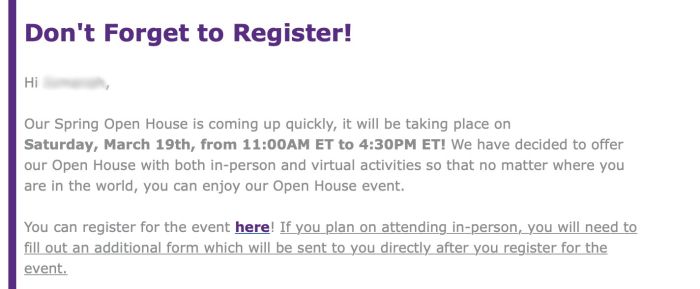
Newsletters are not only a great way to remind and inform subscribers about upcoming events, but they are also a chance for you to initiate them into your school’s community. When you engage prospects in regular dialogue, you familiarize them with your school, its faculty and its offerings, leading them one step closer to enrolment.
5. Measure the Performance of Your Newsletters
A good inbound marketing content strategy is one that you can track, review and revise. An email campaign lends itself well to metrics that allow you to assess the engagement and effectiveness of your content. When it comes to email marketing, there are two things to consider: how are recipients engaging with your newsletter, and what are they doing after they click through to your site?
Some key performance indicators include the number of subscriptions, the number of emails sent and the number of opened emails. If your school uses marketing automation technology, most automated email campaigns will allow you to track open, click-through and conversion rates. In the example below, you can use the data on sent emails, open rates, bounce rates and more to assess the delivery and engagement of your newsletter over a given period of time.
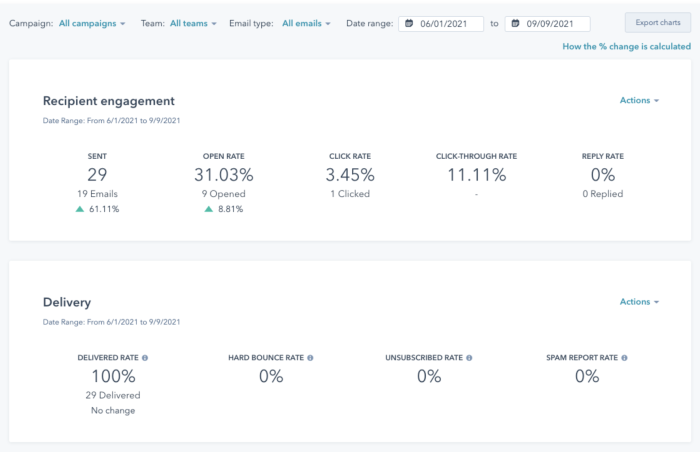
By analyzing this data, your school can implement a more informed content strategy that adapts to the behaviour of digital audiences.
As a form of personalized and consistent messaging, your school’s newsletter is a channel of communication well worth the investment. When you take the time to connect prospects to the information they want, you take a more proactive approach to marketing. In the process, you can ensure that you capture the attention of new leads and nurture their connection to your brand.







